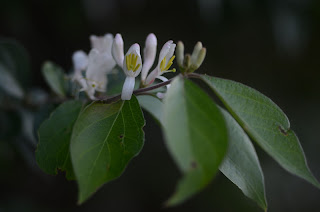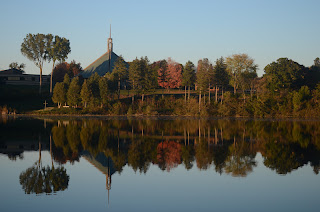Friday night I met Ken at Gallup Park. After meeting with him last week and getting some pictures taken, I was looking forward to it again. I do enjoy shooting with someone else.
While I was waiting for him to show up, I figured I'd get some shots of the leaves. Again, I wasn't shooting with a tripod. I should have. I used my macro lens, and I am remembering just how much I love using that lens. Unfortunately, I was shooting with a very shallow depth of field and this affected the results of most of my shots. I was not using a tripod, and I was, for the most part, using f/2.8 to keep my shutter speed up.
The bad news is that this resulted in some of my pictures being in focus for only part of the image.
The smaller the f-stop, the larger the aperture. That is, with a f-stop of f/2.8, the opening of the lens is wide open. If I were to go to f/32, the other end of the scale for this particular lens, the aperture becomes very small. My depth of field would increase so that pretty much everything would be in focus. Assuming I had focused the lens on my subject.
As the f-stop increases, the aperture decreases. Why does this matter? Well, the smaller the aperture, the longer it takes for a given amount to pass through the opening.
If I increase the f-stop by one step, the aperture becomes a bit smaller. If I do this, half the amount of light will pass through to the film or sensor in the same amount of time. If I want the same amount of light to pass through, the shutter has to remain open longer.
Conversely, if I decrease the f-stop by one step, the aperture
increases. This will allow twice the amount of light to pass through in
the same amount of time. If I want the same amount of light to pass
through, the shutter will remain open for less time.
By manipulating the shutter speed, you can make an image look darker or lighter than the camera would normally appear.
If you increase the f-stop by one step, the aperture decreases by one step. The amount of light passing through the shutter in a given time period is half what it would be with the larger aperture. This means that the shutter speed doubles. It will go from, say 1/125 of a second to 1/250 of a second.
On the other hand, if I decrease the f-stop by one step, the aperture increases by one step. The amount of light going through the shutter in a given period doubles so the shutter speed will halve. If your original shutter speed was 1/125 of a second, it will go to 1/60 of a second.
This may seem overwhelming, but once you figure it out, you can start doing the math in your head and today's more advanced cameras often have settings that let you easily allow them to keep the shutter open for a longer or shorter period of time than it would in automatic mode.
Unfortunately, the trade off is in the depth of field. The smaller the f-stop, the less depth you'll be able to have in focus. This is a big issue in closeup photography.
Here you can see how the small f-stop led to a very shallow depth of field. I was hoping to get the whole cluster in focus without bringing too much of the background into focus.
Here is another example. This is lichen on a tree. The center is in focus, but the top and bottom of the picture are not.
I increased the f-stop here. The top is still a bit out of focus, but for the most part the rest of the picture is okay. I forgot how much of a difference it makes when doing closeup work.
A thistle.
A larger f-stop would have let me get all of this in focus which I think would have made this look better. The trade off would have been a longer shutter speed, which would have worked against me because of the low light. A tripod would have allowed me to maintain the distance between the camera and the subject. Not something easily accomplished when shooting with the camera in your hands.
A tripod and a larger f-stop would have allowed me to frame this better and get all of the leaf in focus. When shooting closeup with a small f-stop any slight movement makes a big difference.
Some milkweed.
A little bigger f-stop. I didn't quite get the detail I wanted. I'll have to go back next week and see if anything still remains.
A nice closeup of the plant.
This still had a bit of color to it.
I increased the depth of field here to try and get the stem in focus.
Concordia College.
This shot didn't quite work out the way I hope it would.
One last shot of Concordia. Although shot with the same lens as the previous picture of Concordia, and within minutes of each other, I like this image better. Mainly because the building isn't obscured by the tree.
Subscribe to:
Post Comments (Atom)



















I like that last milkweed shot.
ReplyDelete